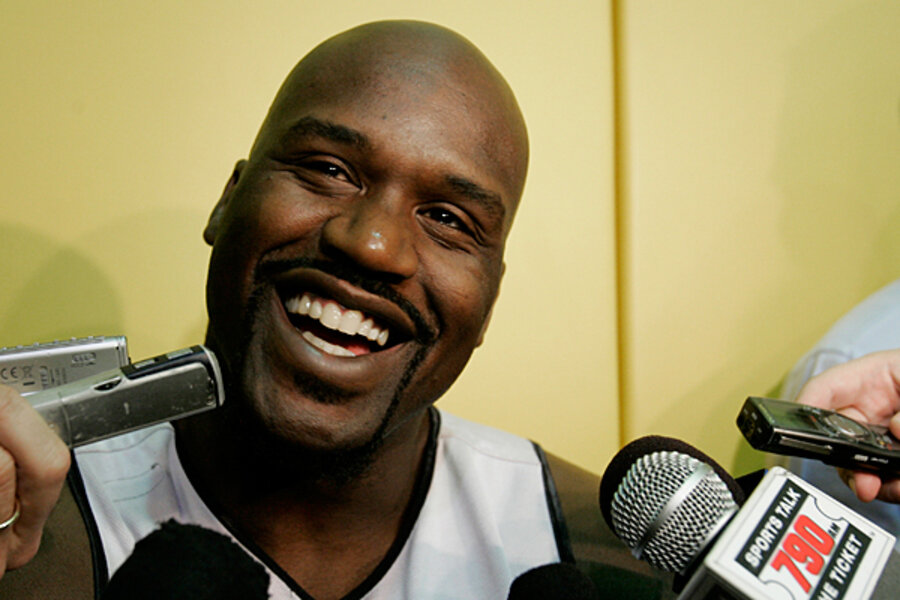Shaquille O'Neal: basketball's larger-than-life big man calls it a career
Loading...
| Los Angeles
Shaquille O'Neal has retired from professional basketball, and Stu Templin, for one, is not shedding any tears.
A Los Angeles Lakers fan enjoying coffee at a local doughnut shop, Mr. Templin loves that O’Neal helped the Lakers win three National Basketball Association championships, but when it comes to O'Neal's style, his assessment is withering.
“He was completely predictable and played like an animal,” Templin says. "Fake left, fake right, back up into his opponent, turn and stuff the ball. Bor-ING!”
Sean Deveney of the Sporting News, however, has a different take: O'Neal was nothing less than a revolution of size and athleticism, he said on an online video. The NBA had never seen his like before.
It is a taste of the different views of the 19-year NBA veteran who was larger than life in so many ways. As a basketball player in his prime, he often seemed to be his own continent, geologic in his vastness, primal in his raw power. As a man, he was his own industry, spawning films, rap music, and even a television show whose sole premise was O'Neal challenging various athletes in their own sports.
On the court, how did he measure up against the all-time great big men – Kareem Abdul-Jabbar, Wilt Chamberlain, Bill Russell, or Hakeem Olajuwon? “Certainly you can make an argument for any of them" being the best of all time,” said Mr. Deveney.
Shaq: The greatest?
While he lacked the elegance of Jabbar's sky hook, the finesse of Olajuwon's low-post moves, or the championship rings of Russell, he had a Jurassic physique (7 feet, 1 inch tall, 325 lbs.) with the nimble feet of a thoroughbred.
“He was able to not just back you down and beat you up, but then drop these little spin moves and hook shots," Deveney said. "Certainly the combination of size and athleticism is something the league had never seen, and for a quite a few years … didn’t know how to defend, didn’t know how to referee, didn’t know how to handle in general, and that was something that will always stand out.”
“If any of them were to play one-on-one in their primes, I am not sure any of them really could have handled Shaq … even Olajuwon,” added Deveney, “Just because of his sheer size and agility and the way he was able to use it. Nobody we’ve ever seen is like Shaq and we’re unlikely to see someone quite like him again.”
Following a standout career at Louisiana State University, O’Neal was drafted by the Orlando Magic in the 1992 NBA draft. Winning rookie of the year, he quickly became one of the most dominant centers in the league, leading the Magic to the NBA finals in 1995.
He signed with the Los Angeles Lakers in 1999 and won three consecutive NBA championships in 2000, 2001, and 2002. He was named MVP of the NBA Finals all three times and had the highest scoring average for a center in NBA Finals history. The Lakers have said they will retire his No. 34 jersey.
After feuding with the Lakers’ other superstar, Kobe Bryant, O’Neal was traded to the Miami Heat in 2004, winning a fourth NBA championship in 2006. He finished out his career with stints at the Phoenix Suns, Cleveland Cavaliers, and Boston Celtics.
Beyond basketball
Yet his footprint on American culture was not confined only to the basketball court. Beginning in 1993, O'Neal began to compose music. He released five studio albums and one compilation album. One critic credited him with "progressing as a rapper in small steps, not leaps and bounds.” He also appeared in films such as “Blue Chips” and “Kazaam.”
It was O’Neal’s lopsided smile and outsize personality that helped him transcend sport off the court. “I think [ESPN columnist] Michael Wilbon said it best when he wrote that Shaq had an understanding that sports is showbiz and what his place is in that universe,” says Chris Corbellini, senior sports writer at The Daily, a web publication for the iPad, in an e-mail. “The guy may have been intimidating to a lot of NBA players, but fans will probably remember him for his smile and acting like a little kid in a giant’s body.” [Editor's note: Mr. Corbellini's quote has been corrected.]
In his final year, O’Neal failed to deliver the championship many in Boston had hoped for. But he ended up bringing the community together in a big way, according to Dan Lebowitz, executive director of the Center for Sport in Society at Northeastern University. As an example of his common touch, he once tweeted that he was headed for Harvard Square, where he sat quietly as a statue for one hour as fans took pictures with him (see video).
“He matured at each stop he made in the NBA and became a communal force here in Boston because he saw his place beyond basketball," says Mr. Lebowitz. "He showed us what humanity is all about, black, white, rich or poor.… It came with his maturation as a human being over the years.”





